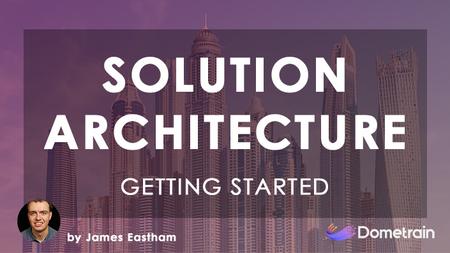English | MP4 | AVC 1920×1080 | AAC 44KHz 2ch | 53 Lessons (4h 47m) | 2.06 GB
Get started with the art of Solution Architecture
No subject in software engineering will add more value to an engineer’s skillset than having a good understanding and, eventually, mastery of the topic of solution architecture. It is the bedrock of everything we do; without it, we can’t create good solutions, no matter how good our code is. The phrase “the right tool for the right job.” rings true with solution architecture more than any other subject in engineering, and knowing when to choose the correct database or even the right technologies to build your solution reasonably, depends on a sound understanding of solution architecture. In this course, James Eastham, Senior Software Architect for Amazon Web Services (AWS), will introduce you to the concept of Solution Architecture and give you all the foundational knowledge you need to master the subject.
Table of Contents
1 Welcome
2 What will you learn in this course
3 Who is the course for and prerequisites
4 Context For The Course
5 What is a software architect
6 The Software Architect’s Elevator
7 The importance of the business context
8 Optimizing for Change
9 Impact as an Architect
10 Defining Architecture Tenets
11 Systems Thinking
12 The Value Of Communication
13 Functional vs non-functional requirements
14 Gathering Functional Requirements
15 Architectural -ilities and understanding trade offs
16 Architect in characteristics
17 Modularity, Coupling and Cohesion
18 Customers & their Access Patterns
19 Monoliths
20 Layered Architecture
21 Hexagonal Architecture
22 Service Oriented Architecture
23 The Fallacies of Distributed Computing
24 Microservices
25 Why Choose Microservices
26 Adopting Microservices
27 Event Driven Architecture
28 Thinking Serverless First
29 Conway’s Law and Aligning Architecture to the Organisation
30 Ocams Razor – Keep It Simple Stupid
31 Choosing the Appropriate Architecture
32 Thinking In Patterns
33 API First Design
34 Streaming Vs Batch Processing
35 Scaling Systems
36 Caching
37 Integration Styles
38 Messaging and Reactive Systems Design
39 Architect for Failure
40 Integrating with External Systems
41 Architecting Data
42 The Importance of Documentation
43 Architecture Decision Records
44 Documenting Use Cases
45 Architect in Patterns
46 The Importance Of Context
47 Context Mapping
48 The Importance Of Interoperability
49 Evolutionary as a default
50 The Importance of Observability
51 Fitness Functions
52 Human-Centric Architecture
53 Architecture In Practice
Resolve the captcha to access the links!
